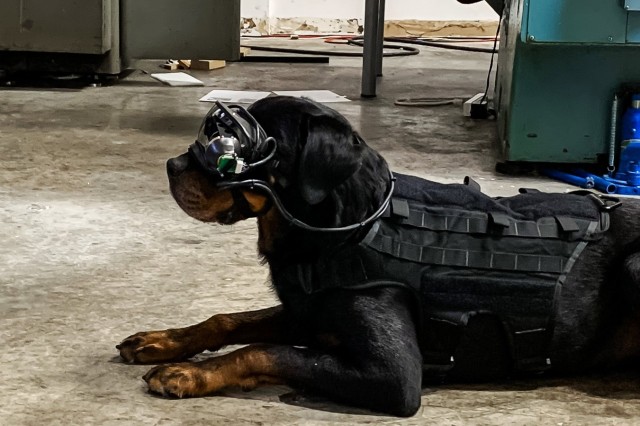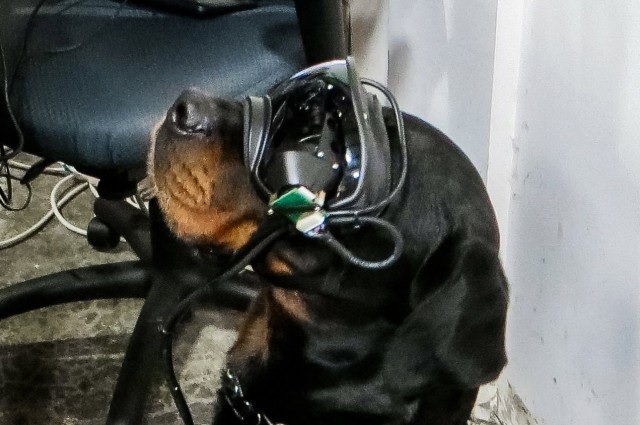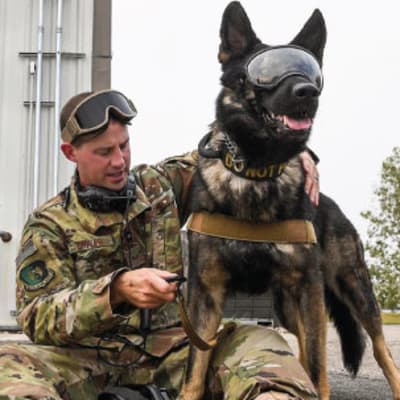
October 8, 2020 – The US Army has recently announced that through a project funded by the Small Business Innovation Research (SBIR) program, a new technology has been developed to provide military working dogs with augmented reality goggles that allow a dog’s handler to give it specific directional commands while keeping US warfighters remote and out of sight.
Military working dogs often scout areas for explosives devices and hazardous materials and assist in rescue operations, but giving dogs the necessary commands to perform these missions can put Soldiers in harm’s way. The US Army is hoping that it can change this by equipping dogs with their own AR goggles.
The project is being managed by the Army Research Office (ARO), an element of the US Army Combat Capabilities Development Command’s Army Research Laboratory, and the tech has been developed by Command Sight, Inc., a small business based in Seattle, US, that aims to bridge human and animal communication using AR.
The AR goggles are specially designed to fit each dog with a visual indicator that allows them to be directed to a specific spot and react to the visual cue in the goggles. The handler can see everything the dog sees to provide it commands through the glasses.
“Augmented reality works differently for dogs than for humans,” said Dr. Stephen Lee, an ARO senior scientist. “AR will be used to provide dogs with commands and cues; it’s not for the dog to interact with it like a human does. This new technology offers us a critical tool to better communicate with military working dogs.”

The initial prototype is wired, keeping the dog on a leash, but researchers are working to make it wireless in the next phase of development.
“We are still in the beginning research stages of applying this technology to dogs, but the results from our initial research are extremely promising,” said Dr. A.J. Peper, Founder and CEO at Command Sight. “Much of the research to date has been conducted with my rottweiler, Mater. His ability to generalize from other training to working through the AR goggles has been incredible. We still have a way to go from a basic science and development perspective before it will be ready for the wear and tear our military dogs will place on the units.”
Currently, military working dogs are commonly directed by hand signals, laser pointers and sometimes audio communication via a walkie talkie placed on the dog. All require handlers to be within sight of the dog, which can pose a safety issue. Furthermore, some commands can lead to confusion for the dog, for example, a dog runs around a set of stairs rather than going up them. As a result, AR goggles could offer Special Forces dogs and their handlers a new alternative.
“The military working dog community is very excited about the potential of this technology,” Lee added. “This technology really cuts new ground and opens up possibilities that we haven’t considered yet.”
The augmented reality system uses goggles that military working dogs have already been wearing for protection in inclement conditions and aerial deployments from Rex Specs. By leveraging a product the dogs are already used to wearing, Peper noted that it makes the technology adoption easier for both the dogs and the handler.

“Even without the augmented reality, this technology provides one of the best camera systems for military working dogs,” Lee continued. “Now, cameras are generally placed on a dog’s back, but by putting the camera in the goggles, the handler can see exactly what the dogs sees and it eliminates the bounce that comes from placing the camera on the dog’s back.”
The Command Sight team has completed the Phase I of the SBIR and was selected to continue to Phase II. The SBIR program funds research and technology development with small businesses using a three-phase process. In contrast to the basic research programs managed by ARO, the SBIR program focuses primarily on feasibility studies leading to prototype demonstration of technology for specific applications.
Additionally, the Department of Defense Rapid Reaction Technology Office has provided funding for the next phase of development. With that funding, Command Sight is now working with Navy Special Forces to build prototypes that will be tested on their military working dogs. Each of the dogs received a 3D scan to get dimensional data to understand where to place optics and electrical components, specific to each dog.
According to the US Army, researchers plan to spend the next two years developing a production level wireless product. Once they have a prototype they will get user feedback and revise the product for manufacturing.
Dr. Peper closed by stating: “ARO has been a critical partner in making technical, training and direct user connections to build ground swell of interest and secure funding sources,” adding, “We’re excited about getting this into the hands of the Soldier, hopefully in just a few years.”
Image credit: US Army / Command Sight / Rex Specs
About the author
Sam is the Founder and Managing Editor of Auganix. With a background in research and report writing, he has been covering XR industry news for the past seven years.
